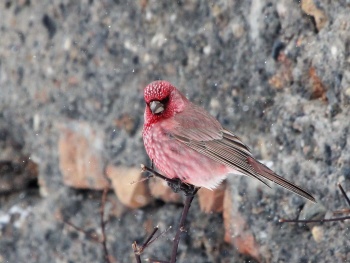
Photo © by orniodesigns
Mount Kazbegi, Caucasus, Georgia
Alternative name: Caucasian Great Rosefinch
- Carpodacus rubicilla
Includes: Spotted Rosefinch
Identification
19–21 cm (7½-8¼ in)
- Large, conical bill
- Slightly notched tail
- Adult male extensively rose-red
- Female and immature largely brown
- Wings of both sexes brown, with pale fringes on tertials but no greater covert wingbars
Similar species
Streaked Rosefinch is closely related and easily confused; it has a more extensive dark face patch. Pine Grosbeak overlaps marginally in the northern Altai Mountains of central Asia; it differs most obviously in conspicuous white wingbars, and is also marginally larger.
Distribution
Found from the Caucasus to the mountains of central Asia and the Himalayas.
Taxonomy

Photo © by Askar Isabekov
Zhabagly, Southern Kazakhstan, February 2014
Subspecies
Four subspecies recognised (sometimes split in two species):
- Caucasus (Caucasian Great Rosefinch):
- C. r. rubicilla in the Caucasus
- Central Asia (Spotted Rosefinch):
- C. r. diabolicus in northeast Afghanistan
- C. r. kobdensis in the Alai Mountains o western Mongolia east to central Altai Mountains
- C. r. severtzovi from Kashmir to Nepal, Tibet and southwest China
The central Asian subspecies are sometimes split as Spotted Rosefinch Carpodacus severtzovi.
Habitat
Alpine areas with low-growing and sparse vegetation.
Behaviour
Diet
They have a varied diet, consisting of flowers, buds, seeds and stems of alpine plants; also berries and insects are taken.
References
- Clements, J. F., T. S. Schulenberg, M. J. Iliff, D. Roberson, T. A. Fredericks, B. L. Sullivan, and C. L. Wood. 2018. The eBird/Clements checklist of birds of the world: v2018. Downloaded from http://www.birds.cornell.edu/clementschecklist/download/
- Gill, F and D Donsker (Eds). 2014. IOC World Bird Names (version 4.3). Available at http://www.worldbirdnames.org/.
- Handbook of the Birds of the World Alive (retrieved August 2014)
Recommended Citation
- BirdForum Opus contributors. (2025) Great Rosefinch. In: BirdForum, the forum for wild birds and birding. Retrieved 4 May 2025 from https://www.birdforum.net/opus/Great_Rosefinch




